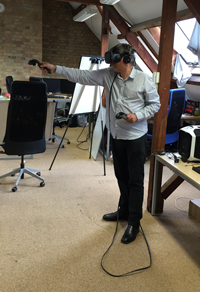Saul Nassé, Group Chief Executive at Cambridge Assessment, looks back at how far virtual reality technology has come, and forward to how it may change the way we learn.
Virtual Reality, or VR, has been the next big thing for thirty years. From its earliest days, the vision was simple: don a headset that puts you inside an artificial three-dimensional world that you can explore and experience interactively. Way back when, I was editor of BBC One science show Tomorrow's World and we enthusiastically made features on the technology's application. The future of video games. Check. The future of remote surgery. Check. The future of art. Check.
That last one was a film I made in the Guggenheim Museum in New York in 1993. Chip-makers Intel had sponsored an installation of virtual reality art, and I went with presenter (and my now wife) Carmen Pryce to film artist Jenny Holzer's VR re-imagining of the war in the Balkans, and musician Thomas Dolby's interactive string quartet. I remember Carmen wasn't wholly impressed.
And so far so slow went VR. The occasional high end niche application, the occasional high profile gimmick. But no breakthrough into the mainstream. Now that's really changing.
At the seriously accessible end of the market is Google Cardboard, which literally is a piece of cardboard you can wrap around your smartphone to create a super-cheap pair of VR specs. We're already experimenting with how we might create immersive experiences for our English learners using this technology.
 Up a notch in tech is the new generation of VR headsets, like the Oculus Rift and the HTC Vive, high end pieces of technology for the price of a decent camera. These are the devices that will really take VR mainstream.
Up a notch in tech is the new generation of VR headsets, like the Oculus Rift and the HTC Vive, high end pieces of technology for the price of a decent camera. These are the devices that will really take VR mainstream.
I had the pleasure of meeting Tom Symonds, CEO of Immerse Learning, the other day. Tom's company is using this new, accessible technology to create learning experiences, and we're exploring with him what the application might be in English. I went down to his company's start-up attic in Clerkenwell, London for a demo of what they've developed so far, and it was fascinating.
I strapped on the Vive (pictured) and its accompanying hand controls and was instantly transported to an oil rig; so convincingly transported that my fear of heights kicked in instantly. But then I got on with the learning. In this case it was an oddly compelling training module showing how to maintain a very intricate piece of petroleum equipment. I had to undo bolts, take it apart, move pieces around and put it all back together. I have seen flight simulators that cost hundreds of thousands of pounds pull off this trick before, but this was technology that only cost a few hundred.
And the technology is only going to get better and cheaper. In two or three years it will be wireless and cost less than a smart phone. That's the point when you'll see whole classrooms equipped with VR. And I like to think we'll find a way of Cambridge English content being used in those classrooms, with people learning English in a whole new way. It may have been a long time coming, but I think the VR revolution is now truly here to stay.
Saul Nassé
Group Chief Executive, Cambridge Assessment